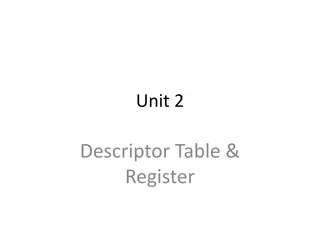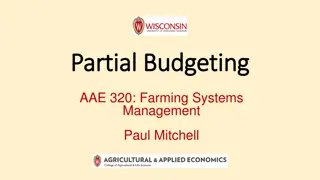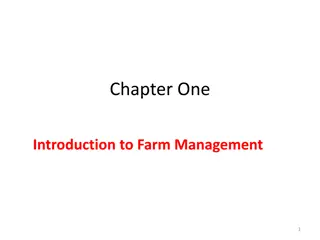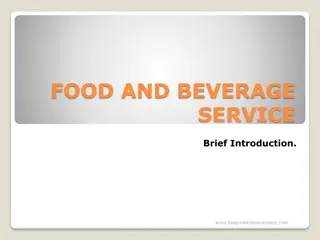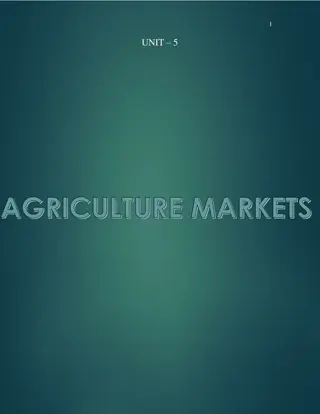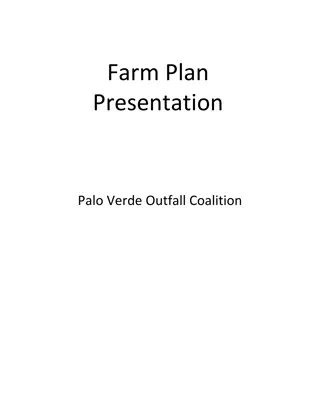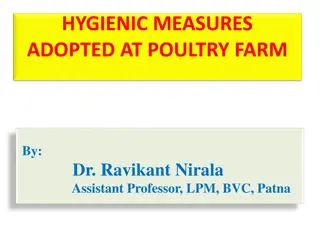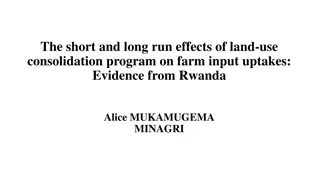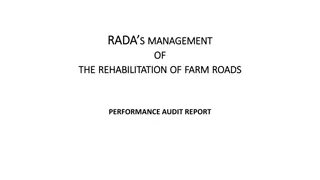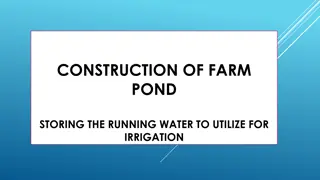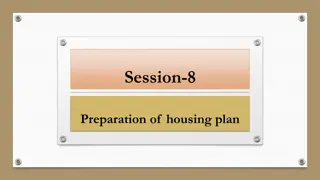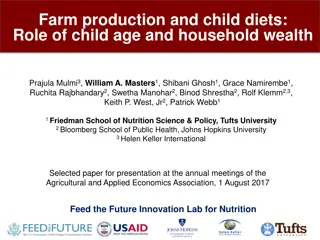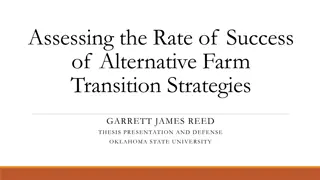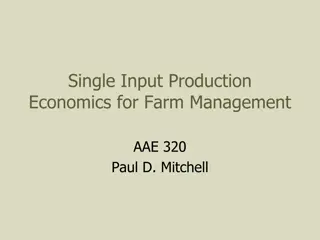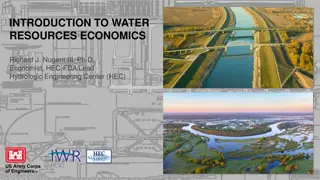Understanding Farm-to-Table Economics
Explore the economic impacts of farm-to-table practices, uncovering the essence of the economy, supply and demand dynamics, and the benefits of supporting local farmers. Delve into the supply chain, economic benefits of farm-to-school programs, profit variances between retailers and farmers markets, and step into the shoes of a crop grower to maximize profits in sweet corn production. Uncover the costs associated with sweet corn production and how they influence profitability in the agricultural sector.
Download Presentation

Please find below an Image/Link to download the presentation.
The content on the website is provided AS IS for your information and personal use only. It may not be sold, licensed, or shared on other websites without obtaining consent from the author. Download presentation by click this link. If you encounter any issues during the download, it is possible that the publisher has removed the file from their server.
E N D
Presentation Transcript
Show Me the Money The Economic Benefits of Farm to Table
What is an Economy? The system by which goods and services are produced, sold, and bought that helps us determine how to use limited resources. Production- What gets made and how? Distribution- How do we get things to people who want them? Consumption- What do people want, how much, and what price?
Supply and Demand Supply How much is available to us? What price can it be sold for? When supply is high, price is high so business receives more revenue Demand How much do we want? What price are we willing to pay for it? When demand is high, price is often low. Think Black Friday sales! Example: Black Friday Shopping
Economics: Supply & Demand Price Price Supply Supply $1 $1 Demand Demand Quantity Quantity 1 1
Economics: Supply Chain Farmer Farmer Processor VS. VS. Table Distributor YOU! YOU! Retailer YOU! YOU!
Farm to School Economic Benefits Farmers have a new place to sell their local food! Local farmers get to keep more $MONEY$ YOU get to eat tasty, local, & healthy food! That $MONEY$ stays INSIDE the community! Jobs Business Community
Profit Difference We ve learned about how selling food locally and to retailers has many different steps . But what is the difference in profit? Retailer This Way We re about to find out! Farmers Market This Way
You Crop Grower, You! You have inherited 10 acres of land from a long lost relative. You ve decided to plant sweet corn on your farm, because it s your favorite vegetable. Your goal: Make the most money possible! Follow along on your Crop Grower worksheet to figure out the best way to do that!
Costs of Sweet Corn Production Ever heard of the saying, you have to spend money to make money? Well, it s true! To produce a corn crop, you will need to think about the following costs. Seeds Land/Fertilizer Water Labor
Costs, continued What are our total costs? Remember, we have 10 acres. Fill in the chart on your worksheet. Calculate the total costs per acre. In order to get the costs for 10 acres, what do we do? Calculate the total costs for 10 acres. COSTS COSTS COSTS COSTS Cost Per Acre Cost Per Acre Cost Per Acre Cost Per Acre Cost Cost for 10 Acres for 10 Acres Cost Cost for 10 Acres for 10 Acres Seeds (Sweet Corn) Seeds (Sweet Corn) $100 $100 Land/Fertilizer Land/Fertilizer $500 $500 Water Water $60 $60 Labor (5 workers) Labor (5 workers) $600 $600 TOTAL: TOTAL:
Gross vs. Net Profit Gross profit Gross profit how much money you get for your crop before expenses. Essentially how much your crop is worth. Assume we can sell 1 acre of sweet corn for $3,400 based on market prices (that fluctuate each year). How can we sell the entire 10 acres of sweet corn for? BUT We had to spent $12,600 in costs of production. Once we pay for those costs, how much is our sweet corn crop worth now? This is your net profit net profit. BUT WAIT!! Depending on where you sell your corn, you may have even more expenses!!
Time to Sell! Farmer Let s say we want our sweet corn to be sold at Walmart. When we sell to a retail store, what other costs do we face? Everyone who touches the corn gets a piece of the profit. Think back to the Supply Chain. Who gets money when you sell to a retail store? When you sell to a retailer, the farmer (you!) only gets 16% of the profit. What s your net profit now? Set up your equation like this: Total Value of 10 Acre Sweet Corn Crop after Costs * .16 Total Value of 10 Acre Sweet Corn Crop after Costs * .16 Processor Distributor Retailer YOU! YOU!
Time to Sell: Take Two! Let s say we want to sell our sweet corn at the local Farmers Market. Let s look at the supply chain. Who else gets money? When farmers sell at the Farmers Market, they keep 100% of the profit. What s your net profit now? Farmer Table YOU! YOU!
Which is best economically? Let s compare net profits. How much did you make selling your crop to Walmart? How much did you make selling your crop at the Farmers Market? Farmers Market Walmart Difference $21,400 $3,424 $17,976
Do you know where to buy local? Farmers Market Farmers Market Farm stands Farm stands Some grocery stores Some grocery stores Gardens Gardens Orchards Orchards Farms Farms Food Banks Food Banks
Have you been to the Farmers Market? 249 West Main Street, Lexington, KY 40507


